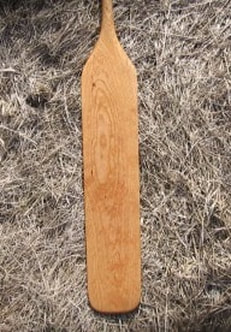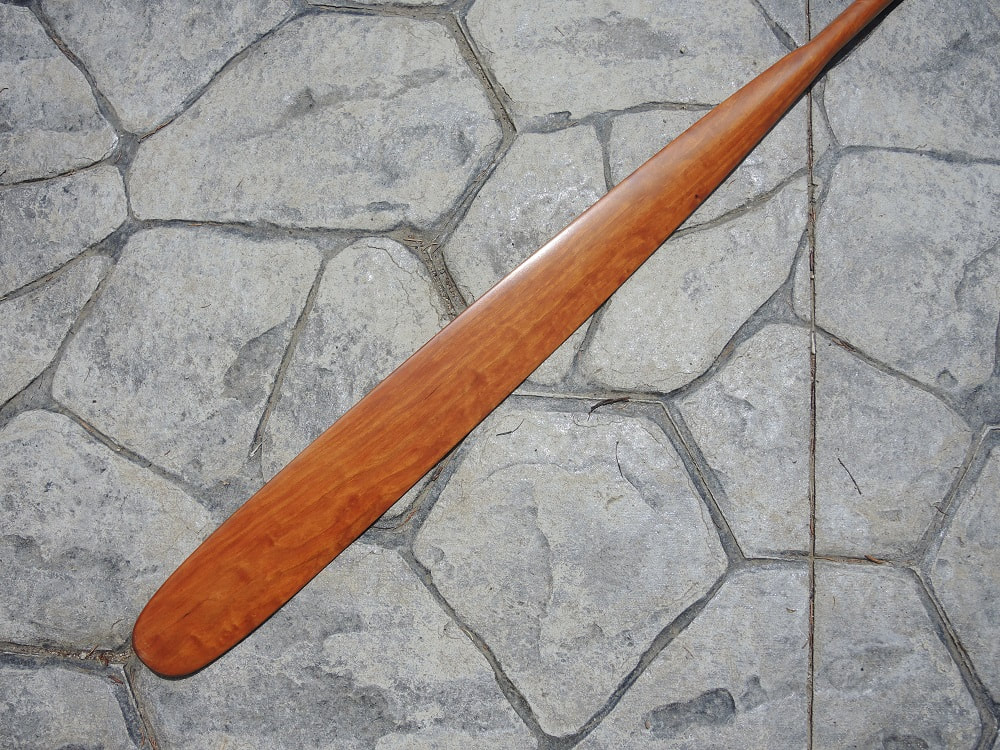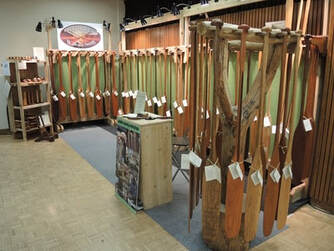The Bruce Smith difference in performance & design
May 1 to October 1, 2024 - I will be taking a sabbatical from custom paddle orders for personal reasons. I plan on adding some more common black cherry paddles to the online sales throughout May and June. I hope to back at it for custom Christmas orders and 2 fall paddle making workshops. Thank you to all my faithfull customers and I'm sorry for the inconvenience. Bruce
With over 55 years' experience, Bruce Smith is one of a rare breed of paddle makers who carves each paddle by hand from start to finish. He uses no automation, no CNC machines, no copy lathe or dupicator, unlike most paddles on the market.Why? The answer is simple. Careful individualized carving allows Bruce to accommodate the innate features of each piece of wood which vary piece by piece, even within the same species.
Did you know that one piece of black cherry lumber can sometimes vary by more than 50% in natural strength and rigidity over another piece that looks the very same in the rough board? So, blade thickness, shaft dimensions, etc. should be varied to accomodate this innate difference in wood fibre strength. Grips, shafts, blades and tips can all be easily customized to meet the customers wishes and needs when done by hand.
As a certified O.C.A. master level canoeist, life long paddler and woodworker, he knows what characteristics are needed to make beautiful paddles that also perform superbly in various settings. It's precisely this blend of woodworking knowledge and canoeing experience that make Bruce Smith's paddles completely unique and worthy of being called "Functional Art."
Did you know that one piece of black cherry lumber can sometimes vary by more than 50% in natural strength and rigidity over another piece that looks the very same in the rough board? So, blade thickness, shaft dimensions, etc. should be varied to accomodate this innate difference in wood fibre strength. Grips, shafts, blades and tips can all be easily customized to meet the customers wishes and needs when done by hand.
As a certified O.C.A. master level canoeist, life long paddler and woodworker, he knows what characteristics are needed to make beautiful paddles that also perform superbly in various settings. It's precisely this blend of woodworking knowledge and canoeing experience that make Bruce Smith's paddles completely unique and worthy of being called "Functional Art."
I have paddled a lot, have been a canoe director at Taylor Statten Camp Wapemeo in Algonquin Park and I want you to know that the paddle you made for me in 1971 is still my favourite paddle of all.
- JILL, TORONTO
Material and WorkmanshipBruce selects only the finest wood with the highest grading standard and are sanded and oiled to a smooth finish. Selecting fine wood yields striking grain patterns and still provides resistance to splitting. The wood grain and colouring create natural "artwork" on the paddle
|
Unique Grip
Bruce’s paddles are designed with a secondary grip below the main grip, which he introduced in 1978 as his proprietary trademark on the market. It was inspired by historical paddles that are no longer in use. A feature which was a favourite among canoe instructors early on, who found it very useful in one handed manoeuvres. They called it the "running pry grip". The running pry and standing pry have always been among the most difficult strokes to master in freestyle or solo paddling.
A word about wood
|
Black Cherry is strong, light, flexible and resilient. Attractive grain, with unique flaws and reds that deepen with time.
Black Walnut is dark in colour with interesting grain and less flexible than cherry (less suitable for rigorous canoeing) but makes a beautiful paddle for recreational use. Maple and ash make durable paddles and are heavier woods, so are carved a little thinner. Long-lasting, but must be maintained like everything else to ensure longevity. European Larch is used when it can be found (grown in North America, despite it’s name) Butternut and sassafras are tough ones to find but make lovely lightweight paddles. |
|
Specialty wood
Butternut is light in colour and has nice grain and tolerates recreational use. Bird's eye maple is rarer and makes a fine paddle; one of the most unique around. Curly maple and tiger maple are other specialty maples. We come across pieces in all woods where the grain has unique figure, is curly, wavy or has unusual blonde or dark streaks. Sassafras is very light weight, stable and flexible. It has a rich history of use in boat building. It is not easy to find but can make a nice recreational paddle.
Paddle Blade Designs
Every blade style that Bruce offers has been either created or honed by him
to achieve his unique version for best possible performance.
to achieve his unique version for best possible performance.
Bruce Smith Classic 27"A popular multi-purpose paddle, designed for solo paddling, lake travel, general tripping with a blade width 5 1/2". The high shoulder also makes it a nice paddle for solo or freestyle paddling. |
Ottertail 28" (and Modified or Tripping Ottertails) A 5 3/8" blade at the top, narrowing at the bottom slightly. A popular design for style manoeuvring, lake travel, recreational tripping.
*A Modified Ottertail is a bit wider at the top with more taper. A less tiring paddle to use on a long days paddle in deep water. 28.5" long. * A Tripping Ottertail is 5 3/4" to 5 7/8" wide the widest point depending on your order. One of Bruce's favourites for tripping in all waters including white water. 29" long. |
Tripper 26"Similar to the Bruce Smith Classic with a fuller configuration (6" wide) allowing to pull more water. Great for spring runs in river travel, strong paddlers and shallow rapids. I also provide Tripper/Classic hybrid which is 5 3/4" wide and less tiring for a more casual paddler. |
Voyageur 27.5"Historically used by the voyageurs, its long, narrow blade, widest at the top, pulls water efficiently without placing excessive strain on the paddler. Very good for distance lake travel and free-style paddling. The blade is generally 5 1/2" wide at the top with taper varying on preference.
|
Morning Mist 29"Based on an East Coast First Nation's design. Bruce's version has less taper on the blade to add a little more strength to the tip. Attractive design and paddles efficiently. Designed for deep water paddling. Generally just under 5 1/2" wide in the middle but width can be customized.
|
Beavertail 27"A greater surface area near the bottom of the blade, enabling it to move larger amounts of water when necessary, but also requiring a little more strength to do so. A Classic design for strong paddlers in windy conditions and big water. The blade is generally 5 3/4" wide near the bottom but can be customized to anything up to 6".
|
"Bruce's paddles are definitely in league of their own, Nothing else like them I have ever seen, tops in appearance, quality craftsmanship, and function."
- MATT, MAINE
Greenland Kayak Paddles
Based on the design of the traditional kayak paddles of the Inuit of Greenland, originally crafted from driftwood washed up on their shores and to which they added pieces of bone along tips and edges for protection from sea ice. The extremely narrow blades allow for the types of strokes traditionally needed to manoeuvre and roll in various situations when hunting by sea and narrow blades didn't catch the wind in the open sea waters. This allowed the Inuit to paddle at a faster pace, covering distances with less fatigue than using wider European blades.
After numerous inquiries, Bruce now offers hand carved designs with his unique stamp of artistry and skill.
If you are interested in a new sea kayak paddle, keep an eye open for Bruce's new Greenland paddle designs due out in late June.
Greenland Bound - A Paddler's Pilgramage
|
To learn more about the whole concept of Greenland paddling, watch this fantastic short documentary filmed in 2014 by our friend James Roberts of the Ontario Sea Kayaking Centre.
Watch for Bruce's custom designed Black Walnut with Curly Maple laminate Greenland Paddle at minutes 2:40-3:15. |
"If Canada picked the 100 most truly Canadian pieces of art to display internationally,
your paddles would be among them.”
your paddles would be among them.”














